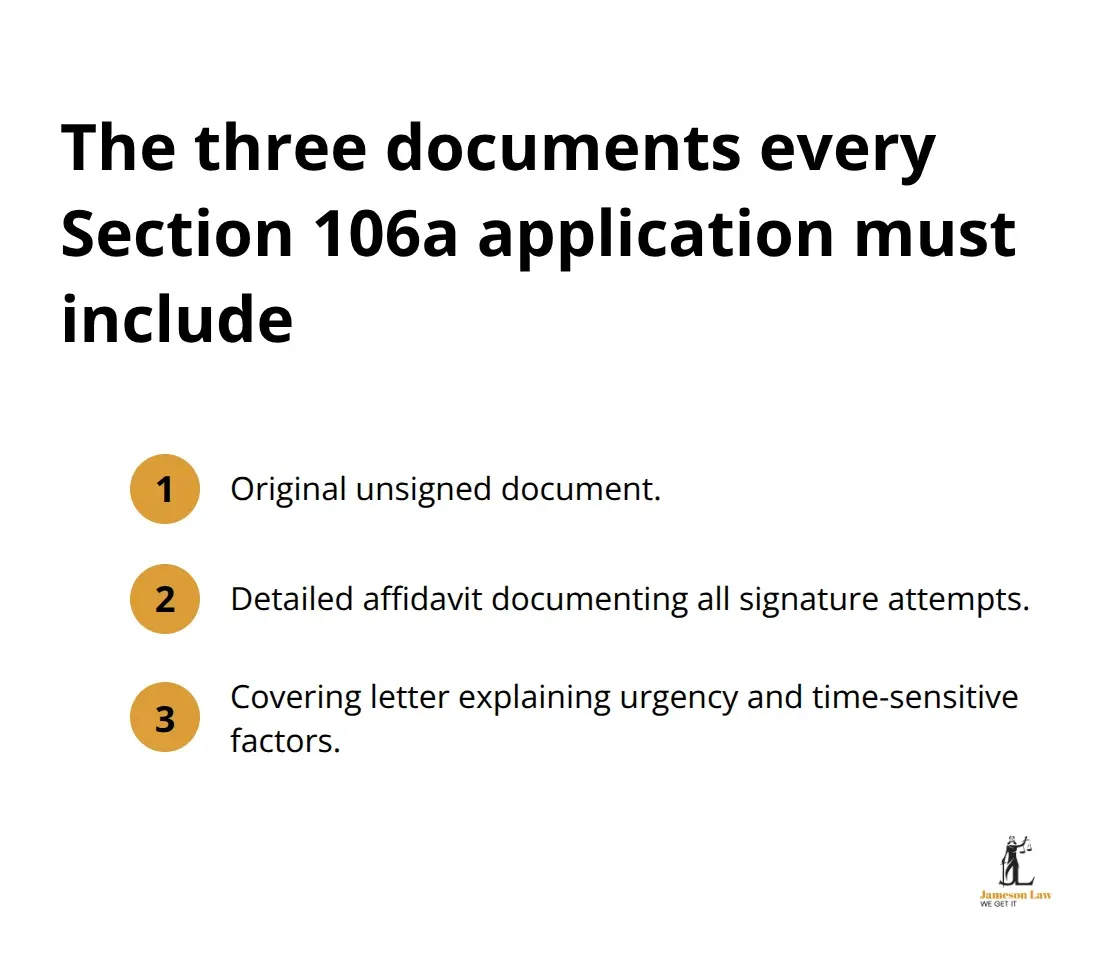Section 106A Family Law Act compliance remains one of the most challenging aspects of family law practice in Australia. Many practitioners and clients in Sydney struggle with the complex documentation and disclosure requirements needed to enforce property orders.
We at Jameson Law, as experienced family lawyers in Sydney, see many firms facing significant penalties due to inadequate preparation. This guide provides practical steps to meet all statutory obligations while protecting your interests from costly compliance failures.
What Does Section 106A Actually Require?
Section 106A of the Family Law Act 1975 serves one primary function: it allows the Federal Circuit and Family Court of Australia to appoint another person to sign documents when a party refuses to comply with court orders. This provision becomes active when someone deliberately obstructs the execution of property settlements or financial arrangements and withholds their signature on transfer documents, mortgage discharges, or other legal instruments.
The Court’s Power to Override Non-Compliance
The court exercises this authority through a straightforward process. When you can demonstrate that your former partner refuses to sign necessary documents despite having a legal obligation to do so, the court can appoint a registrar to execute the documents on their behalf. This appointment carries the same legal weight as if the non-compliant party had signed personally, a vital tool for Section 106A Family Law Act enforcement in NSW.

Mandatory Documentation Requirements
Family law practitioners must submit three specific documents for Section 106A applications: the original unsigned document, a detailed affidavit that outlines all attempts to obtain the signature, and a covering letter explaining the urgency. Courts reject incomplete applications immediately, which delays resolution and increases costs for clients in Parramatta and Sydney.
Evidence Standards and Compliance Obligations
Practitioners face strict evidentiary requirements when they pursue Section 106A relief. Your affidavit must chronicle every communication attempt, including dates and methods of contact. The Court expects comprehensive evidence showing reasonable efforts to secure voluntary compliance. Missing documentation regarding Section 106A Family Law Act attempts will result in application delays.
Penalties and Professional Consequences
Courts impose penalties for practitioners who fail to meet documentation standards. These penalties apply when practitioners submit incomplete applications or fail to demonstrate adequate compliance efforts. Professional negligence claims can also arise when poor preparation leads to delayed property settlements, making meticulous preparation essential.
How to Build a Bulletproof Section 106A Application
Document Every Communication Attempt
Document every interaction with the non-compliant party. The Federal Circuit and Family Court requires evidence of multiple contact attempts spanning at least 14 days. Send formal letters via registered post and emails with delivery receipts. Family law practitioners who maintain detailed communication logs see improved success rates in Section 106A Family Law Act applications.
Perfect the Three-Document Strategy
Prepare your original unsigned document with all parties identified. Draft your supporting affidavit to include the full chronology of compliance efforts. Write your covering letter to emphasise time-sensitive elements like settlement deadlines. Applications must be filed promptly after final compliance requests to receive priority processing.

Meet Critical Processing Timeframes
The Australian Family Court processes complete Section 106A applications efficiently, but incomplete submissions can extend processing significantly. This delay causes client hardship and creates potential liability. Courts impose strict penalties when practitioners fail to demonstrate adequate compliance efforts, making meticulous preparation essential for legal protection in Sydney.
What Destroys Section 106A Applications?
Rushed Client Consultations Create Fatal Gaps
Most Section 106A Family Law Act failures stem from inadequate client consultation records. Practitioners who spend insufficient time on initial client meetings face significant rejection rates. Your notes must capture details about property ownership and potential compliance obstacles.

Disclosure Failures That Trigger Automatic Rejections
Complete financial disclosure is required for all enforcement applications. Applications fail when practitioners omit recent property valuations or outstanding mortgage details. You must do everything a financial or property order requires and take all reasonable steps to ensure proper implementation, a standard practice for reputable solicitors in NSW.
Critical Deadlines That Practitioners Miss
Section 106A applications face strict processing deadlines. Applications filed after initial non-compliance receive delayed processing. Courts prioritise applications that demonstrate immediate compliance efforts followed by prompt legal action. Practitioners who wait months before pursuing relief face additional evidentiary requirements.
Final Thoughts
Section 106A Family Law Act compliance requires meticulous preparation and systematic documentation. Firms that maintain comprehensive communication records achieve significantly higher success rates in enforcement applications.
The Federal Circuit and Family Court processes complete applications efficiently. Practitioners who document every compliance attempt and file applications promptly see measurably better results. Clients benefit from faster property settlements and reduced legal costs.
We at Jameson Law provide expert guidance to navigate these complex requirements effectively. If you need assistance enforcing a court order in Parramatta or Sydney, contact our family law team today.













